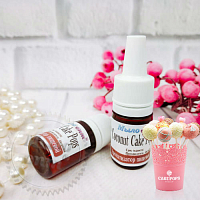-
 Absolutes
Absolutes
-
 Active Complexes
Active Complexes
-
 Actives and Peptides for Cosmetics
Actives and Peptides for Cosmetics
-
 Amino Acids
Amino Acids
-
 Food Flavorings
Food Flavorings
-
 Ayurveda
Ayurveda
-
 Vitamins
Vitamins
-
 Gelling Agents and Thickeners
Gelling Agents and Thickeners
-
 Hydrosols and Floral Waters
Hydrosols and Floral Waters
-
 Hydrolyzed Proteins
Hydrolyzed Proteins
-
 Fragrant and aromatic substances
Fragrant and aromatic substances
-
 Acids, Salts, Alcohols, and Alkalis
Acids, Salts, Alcohols, and Alkalis
-
 Preservatives and Antioxidants
Preservatives and Antioxidants
-
 Cosmetic Raw Materials
Cosmetic Raw Materials
-
 Dyes, Pearlescents, and Glitters
Dyes, Pearlescents, and Glitters
-
 Face Masks, Scrubs, and Dried Flowers
Face Masks, Scrubs, and Dried Flowers
-
 Natural Base Oils for Cosmetics
Natural Base Oils for Cosmetics
-
 Candle Supplies
Candle Supplies
-
 Melt and Pour Soap Bases
Melt and Pour Soap Bases
-
 Base for cosmetics, cream, serum, shampoo
Base for cosmetics, cream, serum, shampoo
-
 Fragrance Oils
Fragrance Oils
-
 Surfactants
Surfactants
-
 Peelings for Skin
Peelings for Skin
-
 Herbal Powders and Plant
Herbal Powders and Plant
-
 Silicones and Conditioning Surfactants for Hair
Silicones and Conditioning Surfactants for Hair
-
 Raw materials for dietary supplements
Raw materials for dietary supplements
-
 Packaging for Cosmetics and Perfumes
Packaging for Cosmetics and Perfumes
-
 Molds, Packaging, Tools
Molds, Packaging, Tools
-
 Organic Extracts
Organic Extracts
-
 Emollients for Cosmetics
Emollients for Cosmetics
-
 Emulsifiers
Emulsifiers
-
 Essential Oils
Essential Oils
Sodium Xylenesulfonate: A Versatile Hydrotrope for Cosmetic Formulations
Discover the multifaceted benefits of Sodium Xylenesulfonate, a highly effective hydrotrope widely utilized in the cosmetic industry to enhance the stability, solubility, and overall performance of various formulations. This anionic surfactant plays a crucial role in ensuring the clarity and homogeneity of complex cosmetic mixtures, particularly those containing poorly water-soluble ingredients like fragrances, oils, and certain preservatives. Its unique molecular structure allows it to increase the apparent solubility of these hydrophobic substances in aqueous solutions, preventing separation, precipitation, and cloudiness, ultimately leading to aesthetically pleasing and functionally superior cosmetic products.
Applications and Areas of Use in Cosmetics:
Sodium Xylenesulfonate's exceptional hydrotropic properties make it an indispensable component in a diverse range of cosmetic applications:
- Shampoos and Hair Care Products: Acts as a solubilizer for fragrances, essential oils, and conditioning agents, ensuring their even distribution throughout the shampoo base and enhancing the clarity and rinseability of the product. It also contributes to the foaming properties and overall cleansing efficacy.
- Body Washes and Shower Gels: Improves the solubility of perfume oils and other additives, preventing them from separating and maintaining the product's transparency and appealing appearance. It also aids in creating a stable and consistent lather.
- Facial Cleansers and Makeup Removers: Facilitates the incorporation of oil-based makeup removers and fragrances into water-based cleansing formulas, ensuring effective removal of impurities without leaving a greasy residue. It also helps to maintain the clarity of gel and liquid cleansers.
- Skin Care Lotions and Creams: Can enhance the solubility of certain active ingredients and fragrances in lotion and cream formulations, contributing to their uniform distribution and stability over time. It can also improve the texture and feel of the product on the skin.
- Sunscreens: Aids in the solubilization of UV filters, ensuring their even dispersion within the sunscreen emulsion for optimal sun protection and preventing crystallization or separation.
- Fragrance Solubilizers: Its primary function in many cosmetic applications is to solubilize fragrance oils in aqueous systems, creating clear and stable fragrance mists, room sprays (indirectly related to personal care), and perfumed products.
- Toothpastes and Mouthwashes: Helps to solubilize flavor oils and other additives, ensuring their even distribution and contributing to the overall sensory experience of oral care products.
- Liquid Soaps and Hand Washes: Improves the clarity and stability of liquid soap formulations, ensuring the even distribution of fragrances and other additives, and enhancing the foaming properties.
Key Benefits for Cosmetic Formulations:
- Enhanced Solubility: Effectively solubilizes poorly water-soluble ingredients like fragrances, oils, and certain preservatives, preventing separation and ensuring product clarity.
- Improved Stability: Contributes to the long-term stability of emulsions and solutions by preventing the precipitation or crystallization of hydrophobic components.
- Maintained Clarity: Ensures the transparency and appealing appearance of liquid and gel-based cosmetic products.
- Uniform Distribution of Ingredients: Facilitates the even distribution of active ingredients, fragrances, and other additives throughout the formulation, ensuring consistent performance.
- Compatibility with Various Ingredients: Generally compatible with a wide range of anionic, nonionic, and amphoteric surfactants.
- Improved Formulation Aesthetics: Contributes to the overall elegance and consumer appeal of cosmetic products.
- Global Shipping: Our online store offers worldwide delivery.
Cosmetic Formulation Example: Clear Tropical Breeze Body Wash
| Ingredient | Percentage (%) |
|---|---|
| Water | 65.0 |
| Sodium Laureth Sulfate (SLES) | 25.0 |
| Cocamidopropyl Betaine (CAPB) | 5.0 |
| Sodium Xylenesulfonate | 2.0 |
| Fragrance Oil (Tropical Blend) | 1.0 |
| Glycerin | 1.0 |
| Preservative (e.g., Phenoxyethanol) | 1.0 |
Instructions:
- In a clean beaker, combine the water and Sodium Xylenesulfonate. Mix until the Sodium Xylenesulfonate is fully dissolved.
- Slowly add the Sodium Laureth Sulfate (SLES) while gently mixing to avoid excessive foaming.
- Add the Cocamidopropyl Betaine (CAPB) and mix gently until well incorporated.
- In a separate small beaker, pre-mix the fragrance oil with a small portion of the Sodium Xylenesulfonate solution (from step 1) to aid in solubilization.
- Slowly add the pre-mixed fragrance to the main batch while stirring.
- Add the glycerin and preservative, mixing thoroughly after each addition.
- Adjust the pH of the formulation if necessary (typically to a slightly acidic pH).
- Mix gently until the body wash is clear and homogeneous.
- Transfer the final product to suitable packaging.
Application Recommendations:
- Sodium Xylenesulfonate is typically used at concentrations ranging from 0.5% to 5.0% in cosmetic formulations, depending on the specific application and the amount of hydrophobic ingredients to be solubilized.
- It is often added to the water phase of the formulation.
- When incorporating fragrance oils, it can be beneficial to pre-mix the fragrance with the Sodium Xylenesulfonate or another suitable solubilizer before adding it to the main batch.
- Ensure thorough mixing to achieve a clear and stable final product.
- Consider the overall surfactant system when formulating with Sodium Xylenesulfonate, as it can interact with other surfactants and affect the foaming profile and viscosity of the product.
- Perform stability testing to ensure the long-term clarity and homogeneity of the formulation.
| INCI | Sodium Xylenesulfonate | |
| Other | ||
| Application | in cosmetics — transparent shampoos, shower gels, bath foams, washing gels in household chemicals — glass cleaners, dishwashing detergents, cleaning concentrates in industry — in the textile and leather industries as a solvent and stabilizer in agrochemistry — a solubilizer for fertilizers and plant protection products in pharmaceuticals — a solvent and solubilizer in liquid forms of dietary supplements and medicines | |
| Att brand | Germany | |
| Color product | colorless | |
| Dosage | in cosmetics — 0.5–4% in household chemicals — 2–10% in agro- and industry — up to 15% in pharmaceuticals — according to formula standards, usually 0.5–2% | |
| Features | All information presented on the site is for reference only | |
| Minimum count | 1 | |
| Name | Sodium xylene sulfonate, 1 L | |
| Other names | sodium xylene sulfonate, sodium salt of xylene sulfonic acid, SXS, Sodium Xylene Sulfonate | |
| Packaging | container for transportation | |
| Packing | 1 L | |
| Properties | reduces the viscosity of surfactant systems, stabilizes aqueous solutions, improves the solubility of essential oils and fragrances, enhances the cleaning and foaming action, promotes the transparency of formulas, reduces the irritating effect of surfactants, is compatible with anionic, nonionic and amphoteric components | |
| Purpose | used as a solvent and solubilizer in aqueous systems, buffer and formula stabilizer, synergist for surfactants, modifier of transparency and fluidity, improves the organoleptic properties of detergents | |
| Solubility | in the water | |
| View | liquid | |
| Valid until | 09.2026 | |










 Add to cart
Add to cart Buy in 1 click
Buy in 1 click

 Add a review
Add a review To favorites
To favorites To compare
To compare















